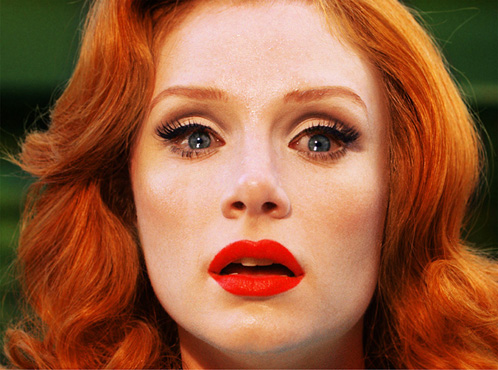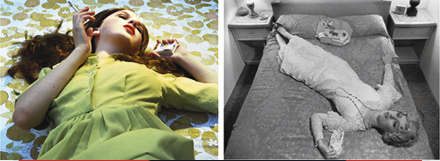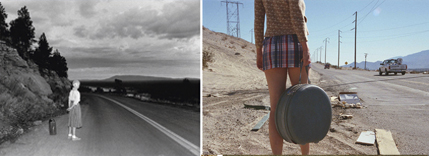
Alex Prager (American, born 1979) Despair. 2010. Chromogenic color print, 16 x 20" (40.6 x 50.8 cm) Courtesy the artist and Yancey Richardson Gallery © 2010 Alex Prager, courtesy Yancey Richardson Gallery

This is now; that was then: LEFT: Alex Prager Desiree from the series The Big Valley. 2008. Chromogenic color print, 36 x 48 1/2" (91.4 x 123.2 cm) RIGHT: Cindy Sherman, Untitled Film Still, 1978, Black and white photograph, 8 x 10 inches, 20.3 x 25.4 cm, Courtesy of the Artist and Metro Pictures, (MP# 11)
There are moments throughout the history of art when, marveling at the latest aesthetic affront, the public, the critics, and even fellow artists have thrown up their hands and asked, "Where can we possibly go from here?"
And, lately, as art has grown ever more referential and every medium, self-referential -- when there is nary an image that does not lay claim to a legacy of irony that is now generations deep: well: what can possibly come next?
Answer: Alex Prager.
The colors are saturated, lurid, one might say; you might think it's a still from a movie, or a perhaps a cover torn off the latest JCrew catalog, but it is neither. It is one of the many super sexy trope-portraits that the artist, Alex Pager, has become known for.
Yes, I went ahead and coined 'trope-portrait' just for Prager's work because it otherwise defies category. These are, after all, not pictures of women, nor are they the loaded narratives constructed by Cindy Sherman, whom she references to heavily; instead, Prager's photos are of tropes. They depict kinds of women in kinds of situations, ones that have already been created and have already been referenced.
And they do it with a no holes barred sexy panache a la David LaChapelle and a shameless balls-out approach to appropriation that snickers at the earnest loyalty of Richard Prince's pix.
Glamour and defiance: this is a have your cake and bath in it too, generation.
Whereas Cindy Sherman referred to movie tropes -- not so much kinds of women as the ways we have told stories about women -- Alex Prager refers to the "capture" as they say in photography, the moment of clarity when what the artist sees gels into what she wants you to see. Sometimes that capture is a sly wink at the viewer, where the focus is shifted toward sheer, brightly lit, sex.

Lost Girls at your mercy: LEFT: Cindy Sherman, Untitled Film Still, 1979, black and white photograph, 8 x 10 inches, 20.3 x 25.4 cm, Courtesy of the Artist and Metro Pictures, (MP# 48) RIGHT: Desert, 2007, © Alex Prager, C-type print, Robert Berman Gallery
These pictures throw wit and cleverness away like so much tedious homework. And although Prager has also tossed aside the postmodern mantle of irony that protects the serious artist from coming off downright crass -- she manages to score big with critics and fans because her references to Hitchcock are flat out endearing, and her David Lynch/Greg Crewdson sense of foreboding keep many of the images on your mind.

LEFT: Alex Pager, Beverly, 2008© Alex Prager, Digital C-Type Print , courtesy Michael Hoppen Contemporary RIGHT: Screen shot of Google Search!
And then there's super-saturated colors that produce an irresistibly juicy wall power.
It's hands-down pretty stuff and you can't help but like it.
Alex Prager, Desiree and Despair: Courtesy, The Museum of Modern Art, New York. Acquired through the generosity of the Contemporary Arts Council of The Museum of Modern Art, Linda and Gregory Fischbach, and William S. Susman and Emily Glasser © 2010 Alex Prager, courtesy Yancey Richardson Gallery